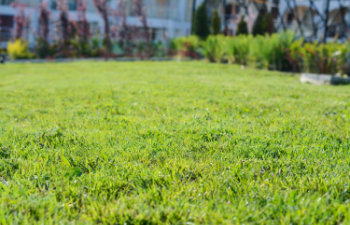
A beautifully manicured lawn can be a homeowner’s pride, serving as a testament to the care and effort invested in nurturing its lush green carpet. However, the occasional appearance of unsightly ruts or depressions can mar this pristine landscape, leading to both aesthetic and functional challenges. Pannone’s Lawn Pros & Landscaping has been addressing these concerns for years, and we’re here to shed light on the primary causes of lawn ruts and how you can prevent them.
Frequent Traffic
Whether it’s the familiar path you tread from your backdoor to your garden shed or the route your kids take while playing, habitual foot traffic can cause soil compaction, leading to depressions.
Prevention: Change your walking routes periodically. If there’s a path you or your family frequently use, consider installing stepping stones or a garden pathway to distribute the weight and minimize the impact.
Lawn Mowing Patterns
Repeatedly mowing your lawn in the same pattern can result in ruts over time, especially if the ground is wet and the mower is heavy.
Prevention: Alternate your mowing patterns. If you mowed vertically last time, go horizontal the next. This not only prevents ruts but also promotes healthier grass growth.
Waterlogged Soil
A lawn that doesn’t drain well or is frequently oversaturated can become soft, making it more susceptible to ruts, especially when weight is applied (like walking or mowing).
Prevention: Ensure your lawn has proper grading for effective water runoff. If drainage continues to be an issue, consider installing a drainage system or consulting with a landscaping professional.
Parking or Driving on Grass
Occasionally parking a vehicle or driving on the lawn, even for short durations, can cause significant ruts due to the weight of the vehicle.
Prevention: Avoid driving or parking on your lawn whenever possible. If you need to access a portion of your property with a vehicle, lay down temporary protective mats or plywood to distribute the weight and minimize damage.
Inconsistent Soil Density
If portions of your lawn have denser soil while others have looser or sandier soil, the areas with looser soil can compact more quickly when exposed to weight, leading to ruts.
Prevention: Consider lawn aeration to alleviate soil compaction. For more consistent soil density across your lawn, consult with a landscaping expert about soil amendments.
Repairing Existing Ruts
If ruts have already formed, there are ways to address them:
- Light Ruts: For minor depressions, spread a mixture of topsoil and compost over the area and then sow grass seed.
- Deep Ruts: Fill the rut with a soil mixture gradually, allowing grass to grow through each layer until the rut is level with the lawn’s surface.
Get a Rut-Free Lawn in Cumming
A rut-free lawn is not only pleasing to the eye but also safer and healthier for the grass and plants. By understanding the causes of these ruts and employing preventative strategies, you can ensure a lawn that remains as flawless as nature intended.
For personalized solutions tailored to your lawn’s unique needs, Pannone’s Lawn Pros & Landscaping is at your service. Let’s work together to ensure a vibrant and resilient lawn for seasons to come.
Posted on behalf of
1444 Buford Hwy
Cumming, GA 30041
Phone: (678) 294-0351
Email: pannoneslawnpros@gmail.com
Monday - Saturday 8:00 AM – 6:00 PM
